Roepera flexuosa
Roepera flexuosa (Eckl. & Zeyh.) Beier & Thulin (= Zygophyllum flexuosum Eckl. & Zeyh.)
Family: Zygophyllaceae
Common names: thin twinleaf (Eng.); spekbossie, spekbroodbossie, maerbossie, skilpadbos, vyfpondbos (Afr.)
Introduction
A bright-flowering and hardy small shrub for the fynbos, succulent or semi-succulent garden alike.
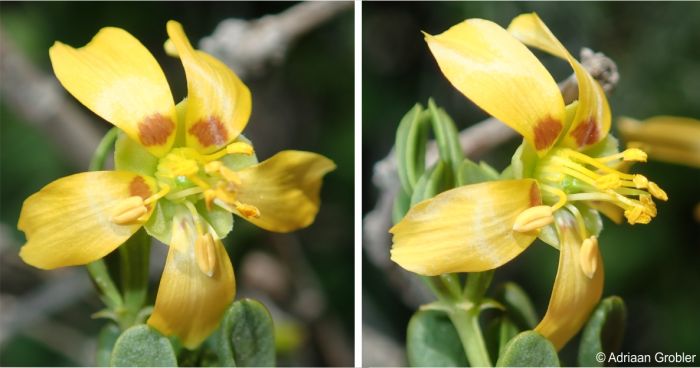
Description
Description
An erect shrub of up to 1 m high and 3-4 m across. The stem is pale and angular. The greyish leaves are sessile, keeled, oppositely arranged and somewhat fleshy. Leaf-size is approximately 10 mm and 4 mm wide. Flowers are solitary, borne on flower stalks in the leaf axils. Flowers vary from 10-15 mm in diameter. Each flower has 5 sepals, 5 to 8 stamens and 5 petals. The light- to golden yellow petals have red markings at the base. Fruits rounded, wider than long, containing sticky seeds. Flowering is in winter and spring, from July to October.
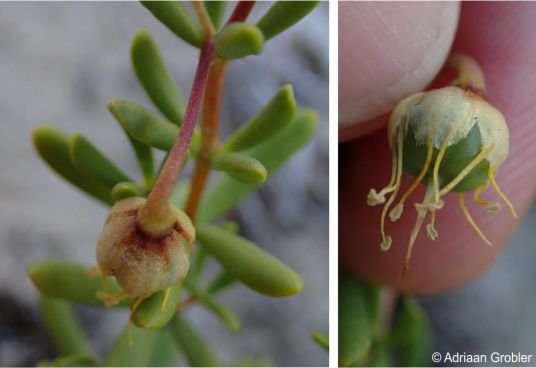
Conservation Status
Status
The Red List of South African Plants lists the conservation status of this widespread species as Least Concern (LC).
Distribution and habitat
Distribution description
This South African endemic is found in sandy to clayey soils and limestones, in some areas often in close proximity to the sea, from Velddrif to Knysna in the Western Cape.
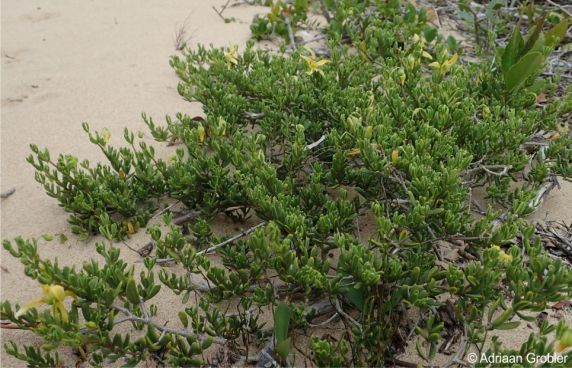
The spekbossie can be found in at least 3 different biomes, Fynbos, Nama Karoo and Succulent Karoo, all with extreme differences in climatic conditions. In the Fynbos it grows mainly in the Cape Flats Dune Strandveld vegetation-type but is also found in others. In the Nama Karoo it has been recorded amongst vegetation types including: Bushmanland Basin Shrubland, Western Upper Karoo, Northern Upper Karoo and Upper Karoo Hardeveld. In the Succulent Karoo it frequents Western Bushmanland Klipveld, Hantam Karoo, Tanqua Karoo and Steytlerville Karoo.
Derivation of name and historical aspects
History
The genus Roepera is named after the German botanist Johannes Christian Roeper (1801-1885). The former genus name Zygophyllum is derived from the Greek words, zygos, meaning ‘joined’, and phyllon, meaning ‘leaf’, in reference to the paired leaves in so many of the species. Linnaeus was first to established this name in 1753 based on the species Zygophyllum fabago. The species name flexuosum is Latin for ‘pliant’ and is likely in reference to its bendable angular stems.
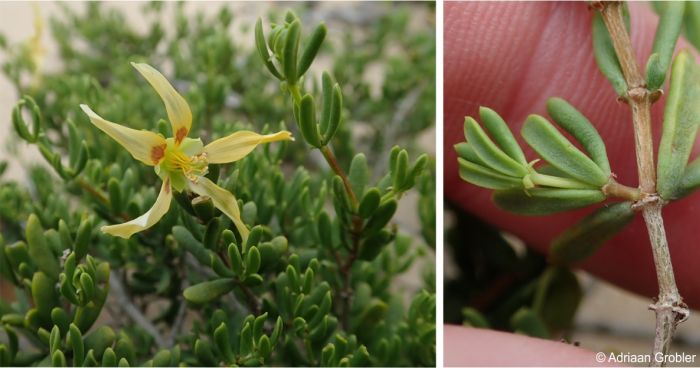
The genus Roepera belongs to the family Zygophyllaceae, a small, cosmopolitan family of about 26 genera and 280 species, known from arid to tropical and warm regions of the world. In 1814 Robert Brown recognised the family Zygophyllaceae as a distinct taxon under the name Zygophylleae. There are approximately 120 species in the family, of which ± 60 species are found in sub-Saharan Africa, with ± 45-50 species in southern Africa. There are also species found in the Mediterranean countries, Asia, Australia, Chile and the United States. In the southern Africa region, the species are prevalent in both winter- and summer rainfall-areas, irrespective of rainfall. The two areas with the greatest number of species present in South Africa are the Nama-Karoo and Succulent Karoo Biomes. The Gariep Centre, in the Northern Cape, is considered the principal centre of diversity and endemism for the genus in southern Africa.
Recent DNA studies in the Zygophyllaceae have caused substantial changes in the ordering of genera and species. This species was originally placed in the genus Zygophyllum until the results of a 2003 study caused it to be moved into the genus Roepera, but it was then proposed that it be moved back to Zygophyllum by a 2008 study that refuted the 2003 study. However, after more studies, it is now largely accepted that Zygophyllum is an Asian genus and the southern African species formerly placed in Zygophyllum are divided into two genera: Roepera formerly subgenus Zygophyllum; and Tetraena formerly subgenus Agrophyllum. Species of Roeperia, including R. morgsana, are characterised by petals with markings at the base or streaked with red veins, a papillate disc and fruit disintegrating when mature. For species in the genus Tetraena, including T. simplex, the petals lack markings at the base, the disc is smooth, and the fruit splits into five parts (mericarps).

This species was named vyfpondbos in the 1950s when an agricultural officer gave a lecture in the field at Zebra in the Oudtshoorn-district (Klein-Karoo region of the Western Cape). This came about when someone in the audience wanted to know whether this plant has a common name in discussing the merits of the plant. The officer replied that despite not being in possession of such, in his opinion each plant, undoubtedly given its grazing-value, as at least worth five pounds (vyf pond). Since then it has been referred to as vyfpondbos. The name spekbossie also refers to its qualities as grazing, because the animals that graze on it are said to become spekvet (as fat as pigs).
Ecology
Ecology
This highly palatable species is often browsed by game. This alters the appearance of the plants, shaping them to morph into a prostrate habit. The seeds are often attacked by insects and therefore healthy seeds are not always available. Bees and other insects have often been observed visiting plants during flowering and may aid pollination by providing some nectar to the insects.
The vyfpondbos has an elaborate, well-developed root system where the main root is able to reach deep into the rocky, clayey soil so typical of it usual habitats. In addition to this, a network of lateral roots is spread about 2 m around a plant.
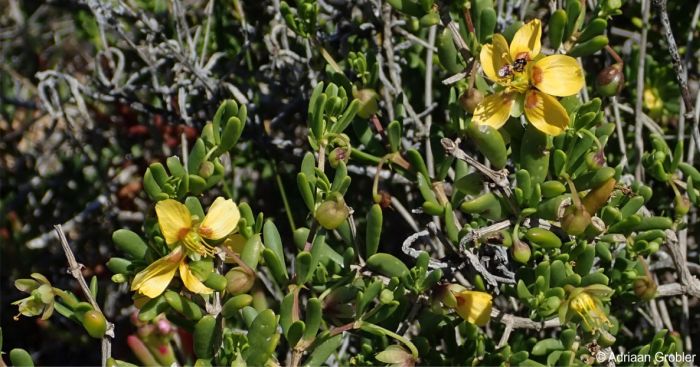
Uses
Use
This species has immense ornamental potential, however, like so many other species of Roepera they are not very well known or promoted in the horticultural industry. There are no known uses as medicinal plants.
Growing Roepera flexuosa
Grow
This species is easily grown from cuttings made during autumn or late spring. Take semi-hardwood cuttings of between 50–80 mm long, cut it below a node and dip in a rooting hormone. Then place cuttings using prepared holes in a well-draining medium consisting of equal portions bark and perlite or coarse river sand. The prepared holes need to be the size of the cuttings more or less. Place cuttings in a mist-unit with a heated bench. Cuttings will root within 3–4 weeks. The rooted cuttings can be hardened-off for 3 weeks and before potting-up. Move the potted plants to a slightly shady area for 2–3 weeks, after which they can be moved into full sun.
Sow seed in autumn in a light, well-drained medium and cover lightly with a thin layer of fine sand. Seed can be subjected to a smoke-treatment. Water the seeds with a fine rose and ensure that the medium does not dry out or that seedlings get overwatered. Pot once the first set of true leaves appear.
There are several species that share a habitat with the spekbossie and make good companion plants in the garden. These may include: Pelargonium fulgidum, P. cucullatum and P. gibbosum, Dimorphotheca pluvialis and D. sinuata, Ursinia anthemoides, Arctotis aspera, A. hirsuta and A. acaulis, Arctotheca calenduliflora and A. populifolia, Cotyledon orbiculata, Lampranthus aureus and L. amoenus, Leucadendron linifolium and L. levisanus, Coleonema album, Agathosma imbricata, A. capensis, A. apiculata, A. glabrata and A. serpyllacea, Salvia lanceolata and S. aurea, Protea repens, Crassula dejecta, Senecio arenarius and S. elegans, Felicia heterophylla, F. dubia and F. filifolia and Roepera morgsana.
This species has no known pests or diseases.
References
- Charters, M.L. 2006–2016. The Eponym Dictionary of South African plants. Published online at http://www.calflora.net/southafrica/1Titlepage.html
- Ferrer-Gallego, P.P. 2018. Nomenclatural types of the Linnaean names in Zygophyllum (Zygophyllaceae). Taxon 67(5):1005-1013.
- Goldblatt, P & Manning, J. 1996. West Coast. South African Wild Flower Guide 7. Botanical Society of South Africa, Cape Town.
- Johannsmeier, M.F. 2016. Bee plants of South Africa. Strelitzia 37. SANBI, Pretoria.
- Manning, J. & Goldblatt, P. 2012. Plants of the Greater Cape Floristic Region 1: the Core Cape Flora. Strelitzia 29. South African National Biodiversity Institute, Pretoria.
- Mucina, L., et al. 2006. Succulent Karoo Biome. In: L. Mucina & M. Rutherford (eds.), Vegetation map of South Africa, Lesotho and Swaziland. South African National Biodiversity Institute.
- Rebelo, A.G., Boucher, C., Helme, N., Mucina, L. & Rutherford, M.C. 2006. Fynbos Biome. In: Mucina, L. & Rutherford, M.C. (eds.), The vegetation of South Africa, Lesotho and Swaziland. Strelitzia 19. SANBI, Pretoria.
- Raimondo, D., Von Staden, L., Foden, W., Victor, J.E., Helme, N.A., Turner, R.C., Kamundi, D.A. & Manyama, P.A. (eds) 2009. Red list of South African plants. Strelitzia 25. South African National Biodiversity Institute, Pretoria.
- Retief, E. 2009-3. Zygophyllum L. (Zygophyllaceae). PlantZAfrica. Online. http://pza.sanbi.org./zygophyllum.
- Smith, C.A. 1966. Common names of South African plants. Memoirs of the Botanical Survey of South Africa No. 35. Government Printer, Pretoria.
- Stearn, W. 2002. Stearn's dictionary of plant names for gardeners. Timber Press, Portland, Oregon.
- Trinder-Smith, T.H. 2003. The Levyns Guide to the plant genera of the south western Cape. Bolus Herbarium, UCT, Red Roof Design CC, Cape Town
- Van der Merwe, B., et al. 2006. Nama-Karoo biome. In: L. Mucina, M.C. Rutherford (eds). Vegetation map of South Africa, Lesotho and Swaziland. South African National Biodiversity Institute, Pretoria.
- Vlok, J. & Schutte-Vlok, A-L. 2015. Plants of the Klein Karoo. Umdaus Press, Hatfield.
Credits
Roger Oliver
Kirstenbosch National Botanical Garden
September 2023
Acknowledgements: the author thanks Adriaan Grobler for making his images available on iNaturalist.
Plant Attributes:
Plant Type: Ground Cover, Shrub
SA Distribution: Western Cape
Soil type: Sandy, Clay, Loam
Flowering season: Spring, Winter
PH: Acid, Alkaline, Neutral
Flower colour: Red, Yellow
Aspect: Full Sun
Gardening skill: Easy
Special Features:
Horticultural zones








Rate this article
Article well written and informative
Rate this plant
Is this an interesting plant?
Login to add your Comment
Back to topNot registered yet? Click here to register.